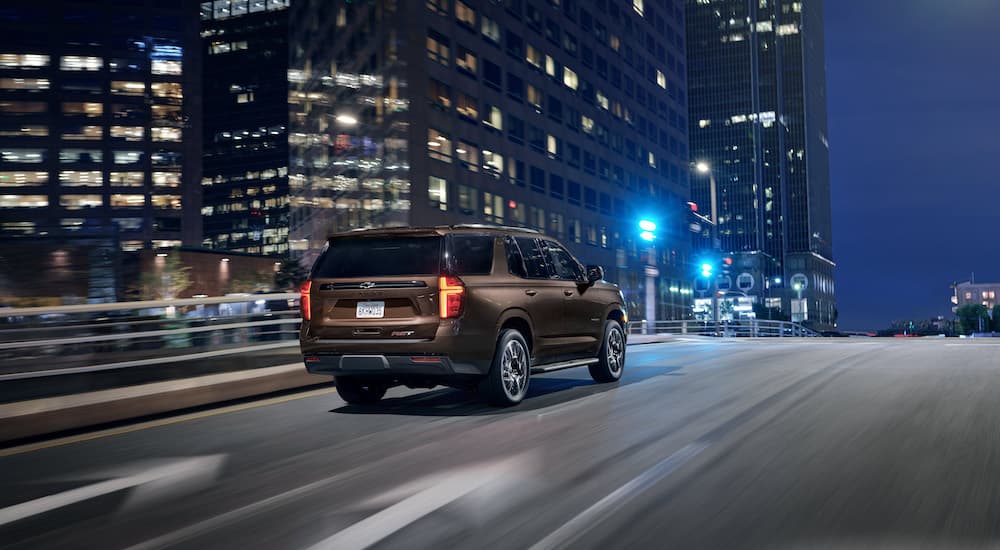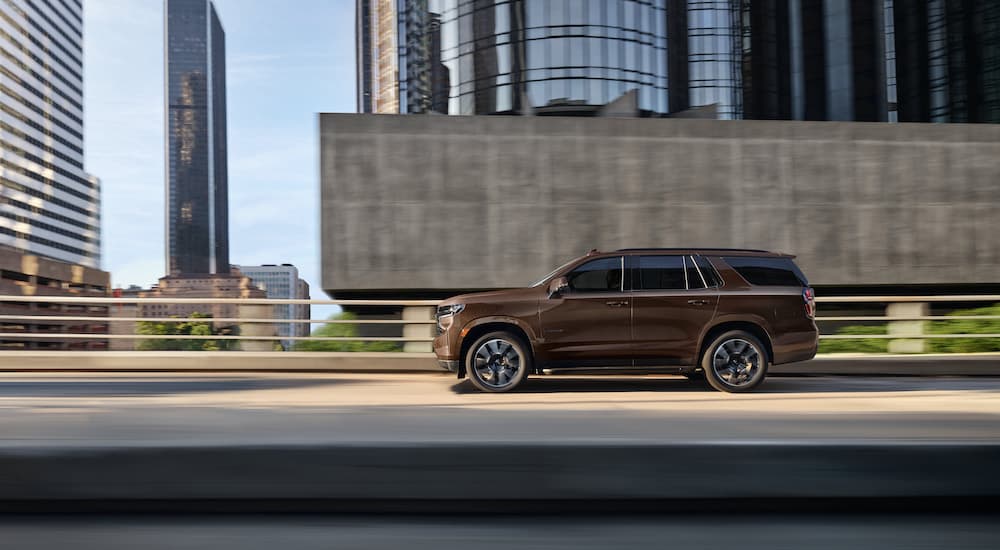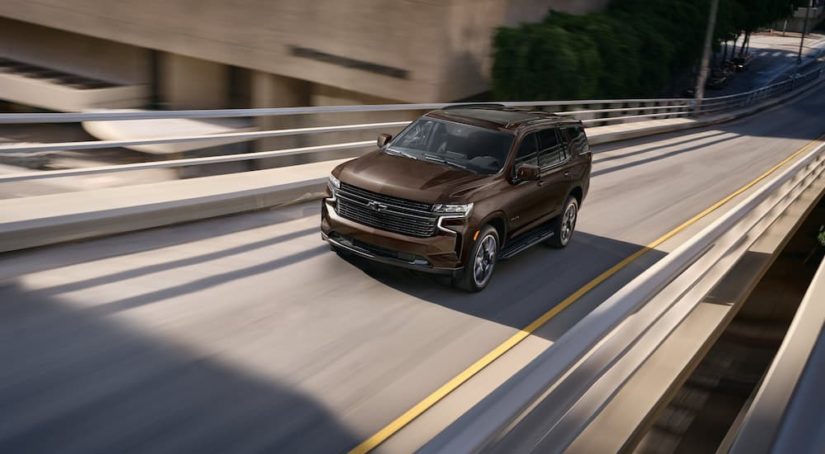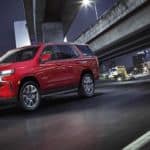There’s been a quiet battle raging in the SUV segment in recent years. It’s not automaker versus automaker or even two specific models duking it out, but rather two drastically different construction techniques competing to see which can best meet the needs of a changing consumer base. Crossover SUVs utilizing unibody construction might be all the rage as of late, but for those who demand the most out of their full-size SUVs, there’s no beating traditional body-on-frame construction. The tried-and-true approach has fallen out of fashion among many brands as of late as consumers increasingly demand more efficient, responsive, and generally car-like SUVs. Still, brands like Chevy are keeping the trend alive with full-size SUVs such as the 2023 Chevy Suburban and 2023 Chevy Tahoe. Still, there’s no denying the popularity of the crossover craze, so why is Chevy opting to stick with the decades-old approach?
The 2023 Chevy Tahoe is part of a vanishingly small class of body-on-frame SUVs. In fact, there are only around a dozen traditional body-on-frame SUV models on offer for the 2022 model year: a stark contrast to the early 2000s when it was the dominant construction approach for almost every SUV and pickup on the market. The popularity of the crossover has come largely at the cost of the body-on-frame segment, which, while still strong, has lost considerable ground in recent years, with crossovers growing from under 4 percent of the auto market in 2000 to nearly 40 percent in 2018.
Despite the rise of crossovers, body-on-frame vehicles remain popular and speak to a larger audience that’s seen drivers gravitate towards larger vehicles in recent years. This is especially true in the US market, where three of the five top-selling vehicles for 2021 were body-on-frame pickups. This technique holds a number of advantages over the newer unibody approach, resulting in tougher vehicles that are better able to withstand the rigors of towing, hauling, and other heavy-duty uses. Let’s see how body-on-frame construction differs from the newfangled unibody approach and outline some of the advantages that have many SUV drivers bucking the unibody trend and opting for body-on-frame models.
Crossover vs Body-On-Frame
Before we dive into some of the specific advantages of body-on-frame construction when it comes to full-size SUVs, let’s step back and define a few terms. While the word “crossover” has become all the rage recently, few drivers understand the specific ways in which this smaller unibody platform differs from the traditional body-on-frame construction techniques that were the standard of the SUV and pickup market for so many years.
In the simplest terms, body-on-frame construction is when a vehicle’s body and chassis start off as two distinct components that are then joined together. For those in need of a refresher, the chassis is essentially the vehicle’s skeleton––the load-bearing framework that supports its powertrain––while the body of the vehicle is essentially the passenger compartment reserved for drivers, riders, and cargo. This technique is as old as the automobile itself, with many of the earliest vehicles to roll off the assembly lines featuring body-on-frame construction. Most smaller passenger vehicles and an increasing number of SUVs have moved away from body-on-frame construction over the decades, though it still remains the dominant approach in the pickup sector.
Unibody construction is a newer technique but not quite as new as some might expect. The unibody approach has been used as far back as the 1920s and became popular thanks to the safety and efficiency advantages inherent to the technique. Unibody design unites the body and chassis into one solid piece, resulting in a combined frame that’s both lighter and more rigid than its body-on-frame predecessors. Chevy was actually one of the first major automakers to embrace the growing unibody trend back in the 1960s, using the cutting-edge technique in the construction of the compact Chevy Corvair. As we mentioned, the approach has increased in popularity within the SUV segment, owing largely to the ease of construction and increasingly strict emissions standards that have seen automakers embrace a host of new technologies in an effort to reduce their vehicles’ environmental impact.

Advantages of Body-On-Frame Construction
While unibody construction has gone a long way in addressing safety, emissions, and efficiency concerns within the SUV segment, the approach has some notable drawbacks when it comes to heavy-duty performance tasks such as hauling and towing. The unibody technique might make sense when it comes to cars, smaller SUVs, and the like, but for those who expect their vehicles to put in a little work, it simply isn’t a good match. Let’s take a look at some of the advantages of body-on-frame construction and see why it remains the go-to approach for hardworking pickups and full-size SUVs like the Chevy Tahoe.
Off-Road Capability
Body-on-frame construction results in a vehicle that’s better able to withstand the twisting forces that can come into play when navigating bumpy off-road terrain. This resistance to destructive twisting forces is even more important for serious off-road applications such as rock crawling, where a vehicle’s frame is routinely subjected to dramatic bumps, weird angles, and plenty of low-end torque. The heavy-duty construction of today’s body-on-frame SUVs also makes them more resistant to jarring impacts and long-term fatigue, saving off-road drivers considerable time and expense on repairs. Body-on-frame SUVs also tend to sit a little higher on the road than their crossover cousins. The improved ground clearance protects the vehicle from moisture, mud, rocks, and other environmental factors. This is especially important in areas with colder weather where the combination of water, snow, and road salt can lead to premature rust on the vehicle’s frame.
Towing and Hauling Capacity
As you’ll soon figure out, many of the advantages of body-on-frame construction come down to sheer strength. The same resistance to twisting, torsional forces that makes full-size SUVs like the Chevy Tahoe such a beast in off-road environs also allow them to excel in the towing realm where strength is the name of the game. Towing and hauling heavy loads can put a lot of stress on the structure of a vehicle, and less sturdy unibody designs just can’t compete with vehicles sporting a body-on-frame design.
Case in point: even the largest crossover SUVs like the Ford Explorer and Nissan Pathfinder top out at towing 5,600 lbs and 6,000 lbs, respectively, when it comes to towing capacity. The Chevy Tahoe, on the other hand, increases the towing capacity up to 8,400 lbs with the addition of the Max Trailering Package. Sure, the SUV’s standard 5.3-liter V8 producing 355 hp and 383 lb-ft of torque helps, but the body-on-frame construction plays a pivotal role in the Tahoe’s towing prowess.
Repair Cost
Due to the modular nature of their design, body-on-frame vehicles tend to be significantly cheaper to repair than their unibody counterparts. When a vehicle with unibody construction sustains serious damage, it often necessitates a complete overhaul since it’s more difficult to replace individual components or mend affected areas. Due to the modular nature of the body-on-frame design, these same drawbacks don’t apply, allowing mechanics to easily fix the frame and body independently of one another.
This unique attribute makes body-on-frame vehicles the go-to choice for some of the most demanding and potentially accident-prone applications, including taxis, police cars, emergency vehicles, and the like. Unibody vehicles can also be more expensive from a design perspective, increasing the cost to consumers as automakers pass on the expense of introducing new models. Creating a new body-on-frame vehicle is as easy as mating a new body to an existing chassis, but when it comes to unibody construction, the entire body often needs to be designed from the ground up.

Cargo/Passenger Room
Body-on-frame vehicles like the 2023 Chevy Tahoe are often referred to as “full-size” SUVs, and with good reason. While crossovers are technically an offshoot of the SUV class, they tend to be smaller than their full-size alternatives and are often closer to lifted sedans than the SUVs of old. This approach has its advantages, offering similar ride height, visibility, and comfort as full-size SUVs, but one area where they fall short is cargo and passenger space. Every crossover on the market is a subcompact, compact, or midsize SUV with no full-size options to be found. This makes crossovers a tough sell for larger families or those who often find themselves packing their vehicles to the gills, as space is often at a premium in the segment.
Take two of the larger midsize crossovers, for example. The Nissan Pathfinder offers 16.6 cu.ft. of cargo space behind its third-row seats, which increases to 45 cu.ft. with the third-row seats folded and 80.5 cu.ft. when both rows are stashed away. The Ford Explorer offers a slightly roomier setup with 18.2, 47.9, and 87.8 cu.ft., respectively, but both pale in comparison to the Tahoe, which boasts 25.5, 72.6, and 122.9 cu.ft. and seating for up to eight.
Comfort
Modern vehicle design is all about reducing three annoying factors: noise, vibration, and harshness, and body-on-frame vehicles do this better than most. In a unibody design, vibrations resonate throughout the entire vehicle, allowing drivers to feel every bump, dip, and crack as they roll down the road. In contrast, body-on-frame SUVs tend to offer a quieter, more comfortable, and more insulated ride thanks to the way they’re built, allowing drivers to get a little distance from some of those irritable vibrations. This is due in part to the fact that body-on-frame vehicles use rubber pads around the bolts that attach the body to the frame, providing a much-needed cushion that prevents excess vibrations while also shielding those in the cabin from the droning sound of the tires. These same attributes also come in handy in off-road scenarios, where this type of insulation can make the difference between a fun day out on the trail and a teeth-rattling excursion that you’re not eager to repeat.
Go-Anywhere Attitude
From comfort and repair costs to off-road prowess and towing capacity, there are lots of advantages to choosing body-on-frame construction when you start shopping for your next SUV. Don’t get us wrong, the crossover trend has done wonders for the industry as of late, allowing drivers to enjoy the perks of the SUV lifestyle––ride height, comfort, and cargo room––in a smaller and more efficient package. But they’re not for everyone. Those who fell for the SUV class for its rugged, go-anywhere attitude will likely find the crossover to be a poor imitation of the style, but there are still plenty of full-size body-on-frame options out there to choose from. The 2023 Chevy Tahoe is a prime example of everything there is to love about this larger class. It offers some of the best towing capacity and cargo room in the game while integrating many of the advanced safety, handling, and fuel economy features that drivers have come to expect from their SUVs.



